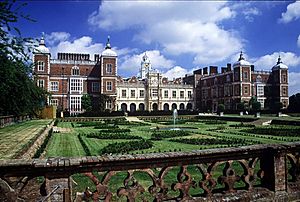William Cecil, 2nd Earl of Salisbury facts for kids
Quick facts for kids
The Earl of Salisbury
|
|
|---|---|

The 2nd Earl of Salisbury by George Geldorp.
|
|
| Born | 28 March 1591 |
| Died | 3 December 1668 (aged 77) |
| Spouse(s) | Lady Catherine Howard |
| Children | 12 (including Charles Cecil, Viscount Cranborne and Elizabeth Cavendish, Countess of Devonshire) |
| Parent(s) | Robert Cecil, 1st Earl of Salisbury Elizabeth Brooke |
William Cecil, 2nd Earl of Salisbury (born March 28, 1591 – died December 3, 1668) was an important English nobleman and politician. He held the title of Viscount Cranborne from 1605 to 1612. William Cecil was a peer, which meant he was a member of the highest social class in England, often with a special title and a seat in the House of Lords. He was also a Privy Councillor, advising the King.
Contents
William's Early Life (1591–1612)
William Cecil was born in Westminster on March 28, 1591. His father was Robert Cecil, 1st Earl of Salisbury, a very powerful man, and his mother was Elizabeth Brooke. Sadly, William's mother passed away when he was only six years old. After that, his aunt, Lady Frances Stourton, helped raise him.
When he was young, William met important people like Queen Elizabeth I. She even gave him special gifts, like a coat, a hat with a feather, and a jewel. He went to school at Sherborne School and later studied at St John's College, Cambridge, starting when he was just eleven. In 1603, he danced with Princess Elizabeth at a royal party.
William's father became an Earl in 1605, and because of this, William received the special title of Viscount Cranborne. When he was 17, his father sent him to France to learn more about the world. However, he was soon called back to England to marry Catherine Howard in December 1608. After his marriage, he went back to Europe, traveling to Italy, including Venice and Padua. He became ill in Padua and decided to return home, vowing not to travel abroad again.
Becoming the Earl of Salisbury (1612–1640)
In 1612, William's father died, and William became the 2nd Earl of Salisbury. He was put in charge of Hertfordshire as the Lord Lieutenant of Hertfordshire, a role where he was known for being very careful and dedicated to the king. In 1624, King James I made him a Knight of the Garter, which is a very high honor.
William Cecil also remained in favor with the next king, Charles I. In 1626, King Charles I made him a member of his Privy Council. This group of trusted advisors helped the king make important decisions. He was also named the Captain of the Honourable Band of Gentlemen Pensioners, a position he held until 1643.
During the 1630s, Salisbury spent a lot of time improving his family home, Hatfield House. He made it a center for art and culture, supporting artists like the painter Peter Lely, the musician Nicholas Lanier, and the gardener John Tradescant the elder.
Role in the English Civil War (1640–1649)
When the English Civil War began in 1642, William Cecil tried to stay neutral. He supported the idea of the House of Commons having more power, but he didn't fully join any side. His lands in Cranborne suffered damage during the war.
In 1648, Salisbury was part of a group that tried to make peace with King Charles I on the Isle of Wight. These talks did not succeed. When the king was later executed, Salisbury refused to approve of this action.
However, after the king's execution, Salisbury decided to support the new government, the Commonwealth of England. This was partly because two of his sons had sided with the Parliament during the war. Also, some of his close friends, like Algernon Percy, 10th Earl of Northumberland (who was also his son-in-law), had supported Parliament.
Life During the English Interregnum (1649–1656)
From 1649 to 1651, Salisbury was a member of the English Council of State, which was the main governing body of England at the time. He even served as its president for a while. He also became a Member of Parliament for King's Lynn.
However, when The Protectorate began under Oliver Cromwell, Salisbury was mostly kept out of public life. Even though he was elected as a Member of Parliament for Hertfordshire in 1656, he was not allowed to take his seat.
Later Years (1656–1668)

After being excluded from public life, Salisbury retired to his home at Hatfield House.
When the monarchy was restored in 1660 with King Charles II, Salisbury was appointed as the high steward of St Albans in 1663.
In his final years, some people noticed that his memory and thinking abilities seemed to decline. One famous diarist, Samuel Pepys, described him as "my simple Lord Salisbury" in 1664. Others said he mostly talked about hunting and hawking.
William Cecil, 2nd Earl of Salisbury, passed away at Hatfield House on December 3, 1668. His grandson, James Cecil, 3rd Earl of Salisbury, became the next Earl, because William's son Charles had died before him.
William's Family
Lord Salisbury married Lady Catherine Howard on December 1, 1608. They had twelve children together, including:
- James, Viscount Cranborne (born and died in 1616)
- Charles Cecil, Viscount Cranborne (1619–1660), who was the father of the 3rd Earl of Salisbury.
- Anne (died 1637), who married the 10th Earl of Northumberland.
- Diana (1622–1633), who died young.
- Catherine (died 1652), who married the 3rd Earl of Leicester.
- Elizabeth (died 1689), who married the 3rd Earl of Devonshire.
- Algernon (died 1676)
- Mary, who married Lord William Sandys.

